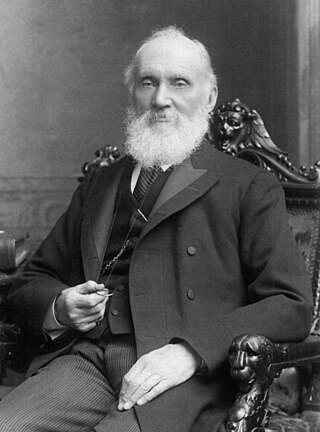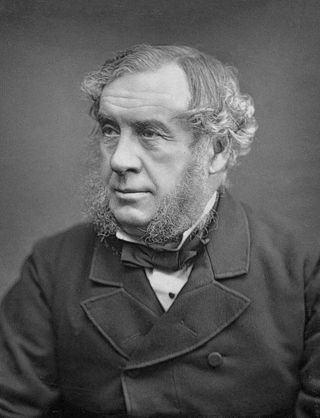Related Research Articles

Michael Faraday was an English scientist who contributed to the study of electromagnetism and electrochemistry. His main discoveries include the principles underlying electromagnetic induction, diamagnetism and electrolysis.

The University of Manchester Institute of Science and Technology (UMIST) was a university based in the centre of the city of Manchester in England. It specialised in technical and scientific subjects and was a major centre for research. On 1 October 2004, it amalgamated with the Victoria University of Manchester to produce a new entity called the University of Manchester.

William Thomson, 1st Baron Kelvin, was a British mathematician, mathematical physicist and engineer born in Belfast. Professor of Natural Philosophy at the University of Glasgow for 53 years, he did important work in the mathematical analysis of electricity and formulation of the first and second laws of thermodynamics, and did much to unify the emerging discipline of physics in its contemporary form. He received the Royal Society's Copley Medal in 1883, was its president 1890–1895, and in 1892 was the first British scientist to be elevated to the House of Lords.

James Prescott Joule was an English physicist, mathematician and brewer, born in Salford, Lancashire. Joule studied the nature of heat, and discovered its relationship to mechanical work. This led to the law of conservation of energy, which in turn led to the development of the first law of thermodynamics. The SI derived unit of energy, the joule, is named after him.

William Sturgeon was an English physicist and inventor who made the first electromagnets, and invented the first practical British electric motor.
Eaton A. Hodgkinson FRS was an English engineer, a pioneer of the application of mathematics to problems of structural design.

Sir William Robert Grove, FRS FRSE was a Welsh judge and physical scientist. He anticipated the general theory of the conservation of energy, and was a pioneer of fuel cell technology. He invented the Grove voltaic cell.
Robert Angus Smith FRS was a Scottish chemist, who investigated numerous environmental issues. He is known for his research on air pollution in 1852, in the course of which he discovered what came to be known as acid rain. He is sometimes referred to as the 'Father of Acid Rain'.
The Manchester Literary and Philosophical Society, popularly known as the Lit. & Phil., is one of the oldest learned societies in the United Kingdom and second oldest provincial learned society.

The Royal Manchester Institution (RMI) was an English learned society founded on 1 October 1823 at a public meeting held in the Exchange Room by Manchester merchants, local artists and others keen to dispel the image of Manchester as a city lacking in culture and taste.
In the history of science, the mechanical equivalent of heat states that motion and heat are mutually interchangeable and that in every case, a given amount of work would generate the same amount of heat, provided the work done is totally converted to heat energy. The mechanical equivalent of heat was a concept that had an important part in the development and acceptance of the conservation of energy and the establishment of the science of thermodynamics in the 19th century.
Edward William Binney FRS, FGS (1812–1882) was an English geologist.

John Peter Gassiot FRS [also Gassiott] was an English businessman and amateur scientist. He was particularly associated with public demonstrations of electrical phenomena and the development of the Royal Society.
John Davies or Davis was an English scientist in Victorian Manchester. He was a lecturer and private tutor who played an important role in the administration of some of the city's learned societies.

Hugh Hornby Birley was a leading Manchester millowner and Tory who is reputed to have led the fatal charge of the Manchester and Salford Yeomanry at the Peterloo Massacre on 16 August 1819.
George William Wood was an English businessman, Member of Parliament and leading member of civil society in Manchester.

The Mechanics' Institute, 103 Princess Street, Manchester, is notable as the building in which three significant British institutions were founded: the Trades Union Congress (TUC), the Co-operative Insurance Society (CIS) and the University of Manchester Institute of Science and Technology (UMIST). In the 1960s it was occupied by the Manchester College of Commerce. It has been a Grade II* listed building since 11 May 1972.

Leopold Hartley Grindon was an English educator and botanist, and a pioneer in adult education. His plant collection and botanical drawings and writings formed a major asset of the herbarium at Manchester Museum, when it was founded in 1860.
The London Electrical Society was established in 1837 to enable amateur electricians to meet and share their interests in “experimental investigation of Electrical Science in all its various branches”. Although it initially flourished the society soon showed weaknesses in its organisation and ways of working. After a period of considerable financial difficulty it closed in 1845.
John Leigh,, was a British 19th-century chemist and surgeon in Manchester, becoming its first appointed Medical Officer of Health, having responsibility for Public Health.